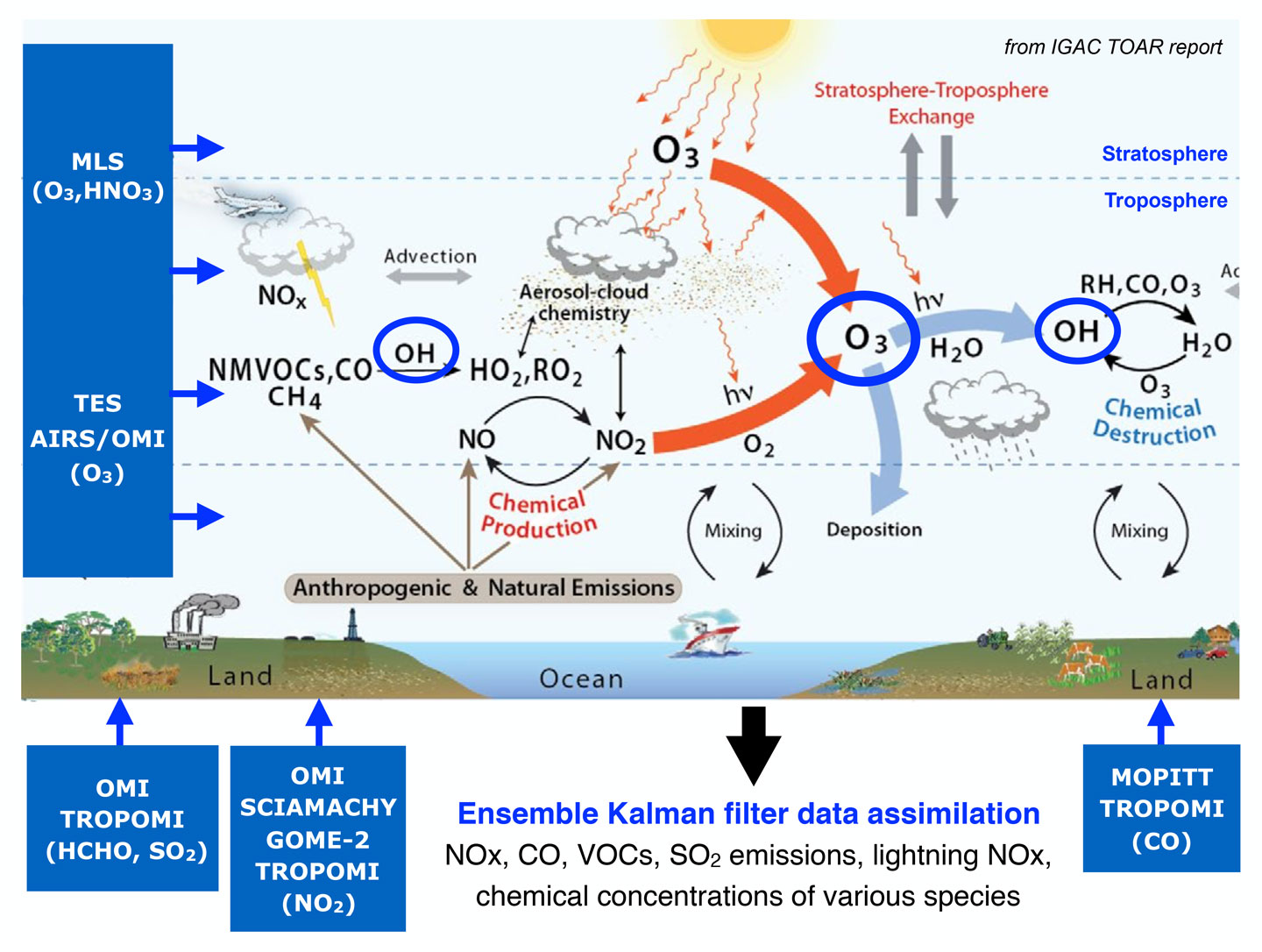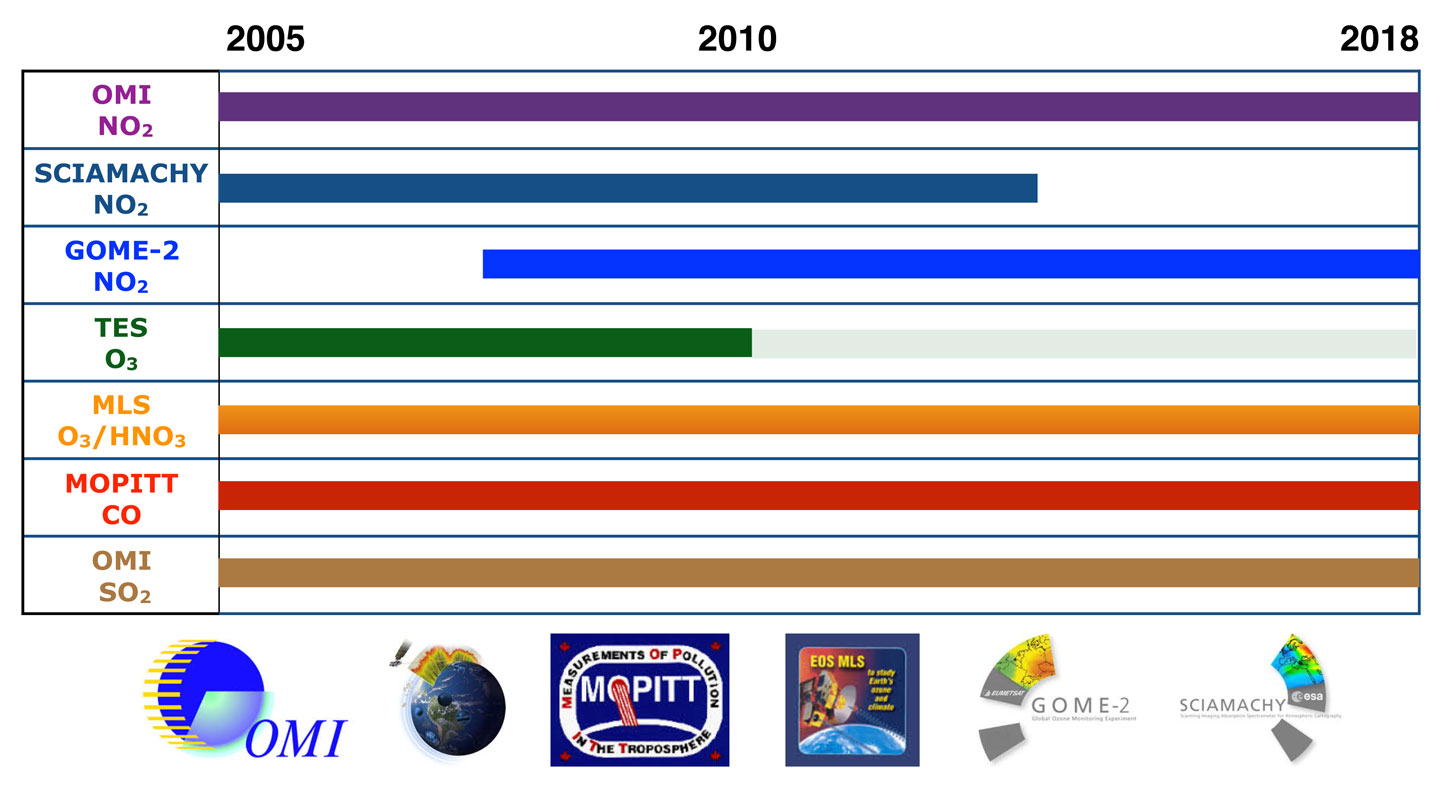Chemical Reanalysis Products
Overview
This web page provides access to a 17-year (2005-2021) global data set of the chemical concentrations O3, NO2, CO, SO2, OH, NO, HNO3, CH2O, PAN, and Aerosols (sulfate, NH3, NH4) and emissions of NOx, CO, and SO2 that are important for air quality and climate.
What is chemical reanalysis?
Chemical reanalysis is a technique that combines observational information from multiple satellite sensors and provides comprehensive information on tropospheric composition variations. In our chemical reanalysis developed at JPL, multi-constituent measurements of O3, NO2, CO, HNO3, and SO2 from the OMI, GOME-2, SCIAMACHY, MLS, TES, and MOPITT satellite instruments were assimilated into a global chemical transport model using an ensemble Kalman filter technique. The methodology is explained in our publications (Miyazaki et al., 2015, 2017, 2019, 2020a, 2020b). The current product has strong observational constraints, especially on ozone and NOx emissions.
What’s available?
| Time period | 2005-2021 |
|---|---|
| Horizontal resolution | 1.1°×1.1° |
| Vertical layers | 27 pressure levels from 1000 to 60 hPa |
| Temporal resolution | Two-hourly, six-hourly, or monthly |
| Variables |
|
For chemical concentrations, we provide data for species that are already validated against independent observations (Miyazaki et al., 2020b).
How is this useful?
Chemical reanalysis data sets have great potential to contribute to studies that could improve our understanding of the processes controlling the atmospheric environment and their roles in changing climate. For example:
- The consistent concentration and emission data provide comprehensive information on atmospheric composition variability from regional to global scales
- The reanalysis data provide initial and boundary conditions for climate and chemical simulations
- The emission data can be used to study emission variability and to evaluate bottom-up emission inventories
The uncertainty information and known issues of the current product are described in Miyazaki et al. (2020b) based on comparisons against independent observations.
Expected applications
- The data sets have great potential to contribute to studies that improve our understanding of the natural and anthropogenic processes that control atmospheric composition. An example: "Reduction in Tropospheric NOx and Ozone Corresponding to Worldwide COVID-19 Lockdowns"
- Evaluation of emission scenarios. An example: “Predictability of fossil fuel CO2 from air quality emissions”
- Initial and boundary conditions for climate and chemical simulations.
What is going on?
- The chemical reanalysis products continue to be updated using the latest satellite observations.
- The updated reanalysis product, TCR-3, is currently under development and will be updated on this website.
- Comparisons against other reanalysis products, including CAMS and MERRA-2 reanalyses, have been made (Huijnen et al., 2019; Park et al., 2020; Elguindi et al., 2020; Ryu and Min, 2020) and will further be updated under the IGAC Tropospheric Ozone Assessment Report, Phase II (TOAR-2) Chemical Reanalysis Focus Working Group activity.
- To further improve the quality and capability of chemical reanalysis, recently developed advanced satellite data, such as multi-spectral tropospheric ozone retrievals from AIRS/OMI (Fu et al., 2018; Miyazaki et al., 2019) and CrIS ozone retrievals, are being added to the assimilation.
- The multi-model multi-constituent chemical data assimilation (MOMO-Chem) framework provides possible uncertainty ranges in the reanalysis fields due to model errors, which are quantified, for instance, in 4 %–31 % for NOx and 13 %–35 % for CO regional emissions. This information is used to evaluate the uncertainty of the reanalysis.
Data release from NASA GES DISC
The chemical reanalysis product is also available on the NASA GES DISC website.
Dataset Citation and DOI
Miyazaki, K., Bowman, K., Sekiya, T., Eskes, H., Boersma, F., Worden, H., Livesey, N., Payne, V. H., Sudo, K., Kanaya, Y., Takigawa, M., and Ogochi, K., (2019). Chemical Reanalysis Products. Jet Propulsion Laboratory. https://doi.org/10.25966/9qgv-fe81

